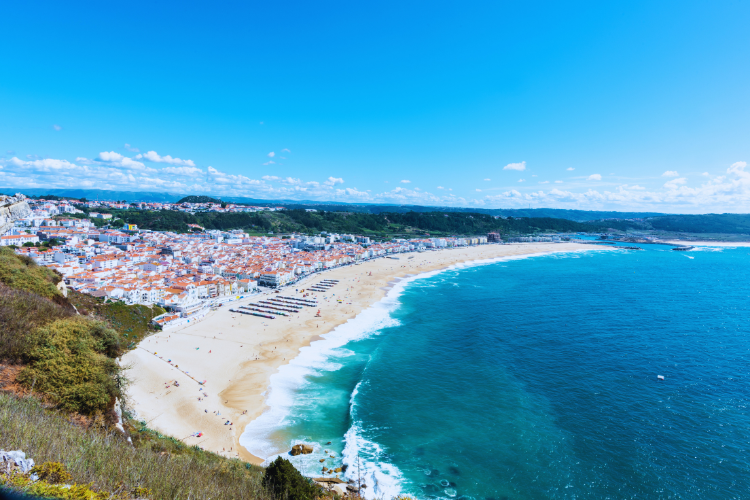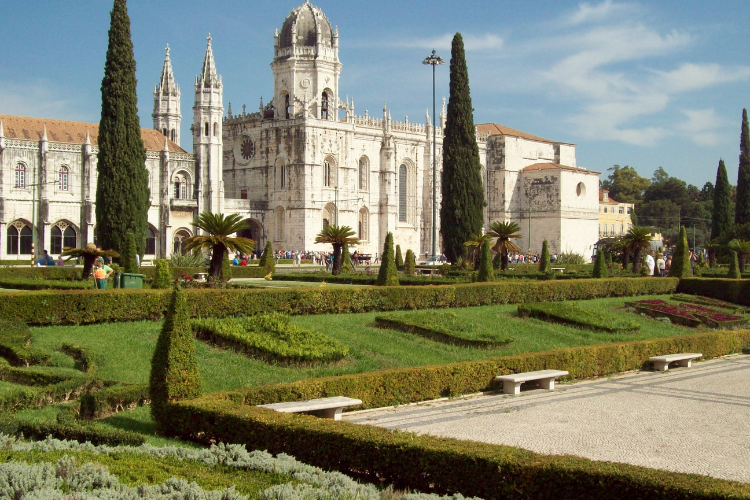Last Updated on December 17, 2024 by Laila Oliveira
In the ever-expanding global landscape, individuals often contemplate relocating to a new country, seeking a better quality of life or diverse opportunities. Two nations that frequently emerge as attractive options for prospective expatriates are Portugal and the United States. In 2024, we can see hundreds of Americans compare Portugal vs the USA!

Each country boasts unique characteristics, offering distinct lifestyles, cultural experiences, and economic environments. This post delves into the comparative analysis of the two countries, aiming to assist you in finding answers to the question: Where should I live in 2024?
Sit tight as we discuss some critical issues distinguishing Portugal vs the USA. Let’s get right in!
Why do people move to Portugal from the USA?
Expats from the USA are increasingly drawn to Portugal for various compelling reasons. One major factor is Portugal’s high quality of life, characterized by a laid-back atmosphere, stunning landscapes, and a Mediterranean climate.
Compared to many parts of the United States, the relatively lower cost of living is also appealing for expatriates. Portugal’s healthcare system is renowned for its efficiency and accessibility, providing an additional incentive for those seeking a reliable healthcare infrastructure.
Moreover, Portugal’s Golden Visa program has become a significant attraction for American investors and retirees. This initiative allows you to obtain residency by qualifying investments in the country, such as real estate acquisitions.
The historic charm, cultural richness, and welcoming local communities further contribute to Portugal’s appeal. Additionally, the country’s strategic location in Europe facilitates travel and exploration.
Portugal Visa Options For Americans
There were several visa options available for Americans interested in moving to Portugal. Some common visas for Americans looking to relocate to Portugal include the following.
- D1 Visa: Subordinated work visa;
- D2 Visa: Independent professional activity or migrant entrepreneurs;
- D3 Visa: Highly qualified activity visa;
- D4 Visa: Study, Higher Education, volunteer visa;
- D6 Visa: Family reunification;
- D7 Visa: Passive income and retirement visa;
- D8 Visa: Digital Nomad Visa;
- Golden Visa: For investors.
To apply for your residency visa, you must contact the representatives of the Portuguese consulates in the United States. When applying for a visa to Portugal, the process starts online. However, the final stage will also require an interview at one of the US application centers (VFS Global). You can find them in New York, San Francisco, or Washington DC.
There is also a possibility to obtain a Residence Permit without requiring a Visa first. That is the case of the Residence Permit for Investment Activity, better known as the Golden Visa.
Documents needed
The specific documents required for Americans looking to move to Portugal are based on the type of residency visa or permit you are applying for. However, here is a general list of documents that you may need.
- Proof of stable and regular passive income (pensions, investments, or rental income);
- Bank statements;
- Proof of health insurance;
- Criminal record certificates;
- Valid Passport.

Comparing healthcare systems in Portugal vs the USA
For anyone looking to immigrate to a new country, healthcare should be essential to your decision-making. While Portugal and the USA have quality healthcare systems, they differ in many ways, from structure financing to access. Here is a detailed comparative overview.
Health insurance
The American and Portuguese healthcare systems diverge significantly in their approaches to medical insurance. In the United States, the system is characterized by a complex web of private insurance providers, employer-sponsored plans, and government programs like Medicare and Medicaid. US health insurance is often tied to employment, with individuals and families selecting plans based on coverage preferences and cost-sharing arrangements.
Conversely, Portugal operates under a universal healthcare system, providing comprehensive coverage to all residents through the National Health Service (SNS). While the SNS covers most healthcare needs, Portuguese residents supplement their coverage with private health insurance, allowing faster access to certain services and amenities. The private insurance sector in Portugal often serves as a complement to the public system rather than a substitute.
Public vs Private Hospitals
The United States and Portugal present notable distinctions in their public and private healthcare approaches. In Portugal, a universal healthcare system, predominantly public through the National Health Service (SNS), ensures that essential medical services are accessible to all residents.
While private healthcare options exist, a significant portion of the population relies on the public system. The emphasis on primary care within the SNS facilitates a comprehensive and inclusive approach to healthcare.
On the flip side, the United States operates a mixed healthcare system where a substantial portion is privatized. Access to healthcare often depends on insurance coverage, whether through employers or individual plans. At the same time, public programs like Medicare and Medicaid assist a considerable segment of the population that relies on private insurance.
The United States’ heavy reliance on private healthcare has its fair share of advantages and disadvantages. While privatization facilitates quality healthcare, it contributes to disparities in healthcare access due to factors like income and employment status.
Because the Portuguese healthcare system is predominantly public, Americans find the services unbelievably inexpensive compared to what they are accustomed to.
Safety in Portugal vs USA
If security is anything to go by, then Portugal is among the best nations for Americans to immigrate to. To put this into perspective, Portugal ranks 7th on the Global Peace Index while the US is 131st.
Portugal has low violent crime rates and is known for its safety, particularly in smaller towns and rural areas. Popular tourist destinations in Portugal, including Lisbon, Porto, and the Algarve region, are generally safe.
However, tourists must remain vigilant, especially in crowded areas and tourist hotspots like in any destination. Portugal has a professional and responsive police force. The police presence is noticeable, contributing to a sense of security.
The safety landscape in the USA is multifaceted and varies across regions. While many parts of the country are safe, others experience higher crime rates, particularly in urban areas.
Cities may contend with street crime and property-related offenses, influencing the overall safety perception. Policing strategies and community engagement also contribute to safety dynamics.
Crime Rates
In Portugal, crime rates, including violent and property crimes, are relatively low compared to many other European and North American countries. The country has a reputation for safety, and its cities and towns are often considered secure for residents and tourists alike.
In contrast, the United States has a more diverse crime landscape. While crime rates have generally decreased recently, certain cities and regions may experience higher crime rates, including violent crimes such as homicide and robbery.
Urban areas often exhibit more crime compared to rural or suburban areas. For some context, the crime rate is 81% higher in the US compared to Portugal, according to NationMaster. Violent crimes involving guns are ten times more common in the US than in Portugal.
Migration laws
Migration laws in Portugal vs USA differ significantly due to variations in immigration policies, legal frameworks, and historical contexts. First, Portugal has several residence permits, including work permits, student permits, and family reunification permits.
The Golden Visa program allows individuals to obtain residency through qualifying investments, such as real estate purchases. Also, citizens of some countries, including the United States, can enter Portugal for short stays without a visa.
However, a visa or residence permit may be required for extended stays or specific purposes like work or study. Note that Portugal is a member of the European Union (EU), allowing EU citizens to live and work in Portugal without needing a residence permit.
On the other hand, the US has a diverse range of visa categories. Popular options include work visas, family-sponsored visas, and student visas. Each category has specific eligibility criteria and application processes.
Permanent residency in the US is often obtained through a Green Card (Lawful Permanent Resident status). This can be through family sponsorship, employment, refugee/asylee status, or the Diversity Visa Lottery.
Foreign nationals with a Green Card can apply for US citizenship through naturalization. This involves meeting specific residency and other eligibility requirements.
Let’s Move to Europe
With Viv Europe your plans for Europe will come to a reality
Cost of living in Portugal vs USA
Besides healthcare and safety, another vital thing to remember when immigrating is the cost of living. It goes without saying that the cost of living in the US is higher than in Portugal. But how do these two nations compare when it comes to the prices of common everyday commodities? Here is a breakdown!
| Item | Expense in Portugal | Expense in the US |
|---|---|---|
| Milk, 1 L | 1.01 $ (0.93 €) | 1.06 $ (0.98 €) |
| Bread, 0.5 kg | 1.51 $ (1.39 €) | 3.58 $ (3.30 €) |
| Rice, 1 kg | 1.47 $ (1.35 €) | 4.63 $ (4.26 €) |
| Eggs, x12 | 3.00 $ (2.76 €) | 3.84 $ (3.53 €) |
| Cheese, 1 kg | 10.55 $ (9.70 €) | 12.99 $ (11.95 €) |
| Chicken Breast, 1 kg | 7.37 $ (6.78 €) | 12.25 $ (11.26 €) |
| Round Steak, 1 kg | 12.66 $ (11.64 €) | 16.11 $ (14.81 €) |
| Apples, 1 kg | 2.16 $ (1.98 €) | 5.38 $ (4.95 €) |
| Banana, 1 kg | 1.35 $ (1.25 €) | 1.70 $ (1.56 €) |
| Oranges, 1 kg | 1.72 $ (1.58 €) | 4.61 $ (4.24 €) |
| Tomato, 1 kg | 2.41 $ (2.22 €) | 4.96 $ (4.56 €) |
| Potato, 1 kg | 1.59 $ (1.46 €) | 3.08 $ (2.83 €) |
| Onion, 1 kg | 1.87 $ (1.72 €) | 3.04 $ (2.80 €) |
Estimates are from Numbeo (as of January 2024).
Lifestyle and entertainment
As these two nations sit on opposite sides of the Atlantic, they showcase unique cultural identities that influence daily life, interpersonal interactions, and societal values.
Portugal is known for its rather easy and laidback lifestyle. People often take the time to enjoy meals, appreciate the natural beauty, and engage in leisurely activities.
The United States is incredibly diverse, both culturally and geographically. Lifestyles vary widely from region to region, and urban areas often have a faster pace of life than rural or suburban settings.
The US is known for a strong work ethic; many Americans highly value career success. Work-life balance can vary, with some individuals embracing a more relaxed approach and others prioritizing professional achievements.
This nation also boasts a robust consumer culture, with a wide range of shopping options, entertainment choices, and a diverse culinary scene influenced by various cultures.
Education System
The education systems of Portugal vs USA share similarities but exhibit key differences shaped by their unique historical, cultural, and administrative contexts.
Regarding structure, the Portuguese education system comprises three main cycles: Basic Education (1st to 9th grade), Secondary Education (10th to 12th grade), and Higher Education. Higher Education includes universities, polytechnic institutions, and private institutions.
As for the US, the education system consists of three main levels: Elementary and Secondary Education (K-12), Higher Education (undergraduate and graduate levels), and Postgraduate Education (professional and doctoral programs).
Another difference is in the school grading system. Portugal often employs a 0 to 20 grading scale, with 10 as the minimum passing grade. Some institutions also use a simplified scale from 0 to 5.
The US typically uses a letter grading system (A, B, C, D, F) with corresponding grade point averages (GPA). The GPA is often on a 4.0 scale, with an A being 4.0 and an F being 0.0.
Portuguese higher education institutions include universities and polytechnic institutes. Universities offer a broader range of academic programs, while polytechnic institutes focus on more practical vocational Education.
US higher education institutions include universities, which can be research-focused or offer a wide range of programs, and colleges, which may focus on undergraduate Education. Community colleges offer two-year associate degrees.
Public vs Private Schools
The education system in Portugal and the US is known for its quality, whether you choose to go private or public. However, it is quite common for foreign nationals to choose private schools for a few reasons.
First, the language barrier. The primary language of instruction in public schools in Portugal is Portuguese. However, private schools are taught in English or another foreign language of choice.
Secondly, private schools may offer internationally recognized curricula, such as the International Baccalaureate (IB) or British Curriculum. Expat families might value the familiarity and transferability of these curricula if they anticipate relocating again in the future.
Public schools in Portugal are free (excluding books and stationery). Private Education is accessible, from early childhood and elementary institutions to secondary Education, international schools, and Higher Education. Choosing private schooling can entail a substantial financial commitment.
Culture
The grandeur of the US, a multicultural nation, starkly contrasts the intimate charm of Portugal, a country with a history deeply rooted in European traditions. Speaking of tradition, Portugal has a rich cultural heritage, and traditional festivals are celebrated yearly.
Festivals often involve music, dance, and local traditions. Also, family is an essential aspect of Portuguese life. Family gatherings are significant, and meals are often a time for socializing and bonding.
Americans, on the other hand, have holidays. The US celebrates various holidays, including Independence Day, Thanksgiving, and diverse cultural festivals reflecting its multicultural population.
Social interactions and etiquette are also quite different between the two nations. Portuguese culture places value on personal relationships and hospitality. Greetings often involve warm embraces and cheek kisses. US culture tends to be more informal, with handshakes being a common form of greeting. Personal space is often emphasized, and individualism is a notable cultural trait.

Gastronomy
The culinary traditions of Portugal vs USA share certain similarities, yet they also exhibit significant distinctions. These differences reflect each country’s unique culinary traditions, ingredients, and cultural influences.
Portugal’s coastline influences its cuisine significantly. Seafood features prominently in Portuguese dishes, including codfish (Bacalhau), sardines, and octopus. The United States is a melting pot of diverse cultures, and its cuisine reflects this diversity. American gastronomy includes influences from Native American, European, African, Asian, and Latin American traditions.
Bread is a fundamental part of Portuguese meals, and each region has its specialty. Pastries like Pastel de Nata (custard tart) are beloved treats. The US is known for its fast-food culture, with iconic items like hamburgers, hot dogs, and fries.
Fast-food chains are widespread, contributing to convenience and quick meals. One similarity that both nations share is the regional culinary specialties. Each region in Portugal has its culinary specialties. For example, the north is known for hearty dishes like Francesinha, while the Alentejo region is famous for its bread and pork dishes.
The same is true for America; the Southern United States is known for fried chicken, biscuits, and gumbo, while the Northeast has clam chowder and lobster rolls.
Best Cities For American Expats in Portugal
Based on geographical size alone, Portugal is significantly smaller than the USA. However, you will be surprised how much nature, beauty, and culture are packed in such a small space.
Because of that, it is often quite overwhelming to choose where to live. Here is a list that will help narrow your options:
- Lisbon: The country’s capital and economic center.
- Porto: Located in the northern region and doubles as Portugal’s second capital.
- Lagos is a charming city of the sunny southern region, the Algarve;
- Coimbra is home to one of Europe’s oldest universities and has a rich cultural heritage.
- Braga: One of Portugal’s oldest cities, Braga combines historical charm with youthful energy due to its university population.
- Setúbal: beautiful city located only 40 minutes south of Lisbon;
- Cascais: Located on the coast near Lisbon, Cascais is a charming seaside town known for its beaches, marinas, and cultural events.
Need help to move to Portugal from the USA?
There you have it, a detailed comparison of Portugal vs the USA. If you have already decided to relocate to Portugal, consider contacting our team at Viv Europe. Let us help you make the move effortless and worthwhile. Book a consultation, and our team will guide you through every step!
Interested in interacting with other Americans in Portugal? Join thousands of other American expats in Portugal on our Facebook Group – All About Portugal For Expats.





